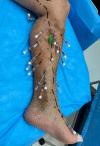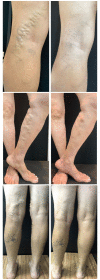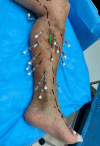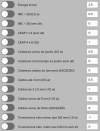Assisted total thermal ablation: presentation of the ATTA technique
- PMID: 36452404
- PMCID: PMC9675071
- DOI: 10.1590/1677-5449.202200481
Assisted total thermal ablation: presentation of the ATTA technique
Abstract
Treatment of lower limb chronic venous disease has progressed exponentially over recent decades. The advances achieved have made it possible to develop a proposal for a systematized intravenous laser ablation technique - assisted total thermal ablation (ATTA). The technique constitutes a standardized method for management of axial or tributary veins that are varicosed or esthetically unappealing, whether in the lower limbs or other areas, that can be performed on an outpatient or day-hospital basis. This article describes the processes for preoperative preparation and detailed marking, the materials needed, venous access, anesthesia, calculation of power and energy, the ablation technique itself, follow-up, and adverse events. The ATTA technique is proposed as a tool for treatment of chronic venous disease and of esthetically unappealing veins, suggesting possible extension of the applications for lasers beyond trunk veins to any vein that can be punctured.
Resumo: O tratamento da doença venosa crônica dos membros inferiores evoluiu de forma exponencial nas últimas décadas. Tais avanços permitiram o desenvolvimento de uma proposta de execução técnica sistematizada para o tratamento de ablação endovenosa com laser, a ablação térmica total assistida (ATTA). A técnica propõe um método padronizado de abordagem das veias axiais ou tributárias, varicosas ou inestéticas, de membros inferiores ou outros territórios, em regime ambulatorial ou de hospital-dia. Foram descritos os processos de preparo pré-operatório, marcação detalhada, materiais necessários, acessos venosos, anestesia, cálculo de potência e energia, a técnica de ablação, seguimento e eventos adversos. A ATTA é proposta como uma ferramenta para o tratamento da doença venosa crônica e das veias inestéticas, sugerindo possíveis expansões para as aplicações do laser, além dos troncos venosos, para toda veia passível de ser puncionada.
Keywords: esthetics; laser treatment; quality of life; saphenous vein; varicose veins; venous insufficiency.
Copyright© 2022 The authors.
Conflict of interest statement
Conflicts of interest: MAM received fees for participating in events from Bayer, Pfizer, Ache and Sanofi.
Figures












References
-
- Navarro L, Min RJ, Boné C. Endovenous laser: a new minimally invasive method of treatment for varicose veins--preliminary observations using an 810 nm diode laser. Dermatol Surg. 2001;27(2):117–122. - PubMed
LinkOut - more resources
Full Text Sources
